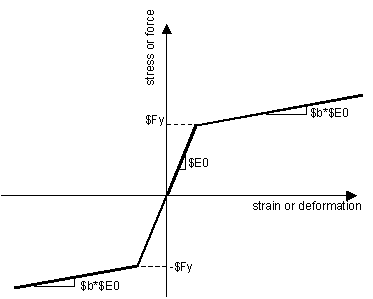Triple Friction Pendulum Bearing Element
- Command_Manual
- Tcl Commands
- Modeling_Commands
- model
- uniaxialMaterial
- ndMaterial
- frictionModel
- section
- geometricTransf
- element
- node
- sp commands
- mp commands
- timeSeries
- pattern
- mass
- block commands
- region
- rayleigh
- Analysis Commands
- Output Commands
- Misc Commands
- DataBase Commands
This command is used to construct a Triple Friction Pendulum Bearing element object, which is defined by two nodes. The element can have zero length or the appropriate bearing height. The bearing has unidirectional (2D) or coupled (3D) friction properties (with post-yield stiffening due to the concave sliding surface) for the shear deformations, and force-deformation behaviors defined by UniaxialMaterials in the remaining two (2D) or four (3D) directions. To capture the uplift behavior of the bearing, the user-specified UniaxialMaterial in the axial direction is modified for no-tension behavior. P-Delta moments are entirely transferred to the concave sliding surface (iNode). It is important to note that rotations of the concave sliding surface (rotations at the iNode) affect the shear behavior of the bearing. If the element has non-zero length, the local x-axis is determined from the nodal geometry unless the optional x-axis vector is specified in which case the nodal geometry is ignored and the user-defined orientation is utilized.
| element TFP $eleTag $iNode $jNode $R1 $R2 $R3 $R4 $D1 $D2 $D3 $D4 $d1 $d2 $d3 $d4 $mu1 $mu2 $mu3 $mu4 $h1 $h2 $h3 $h4 $H0 $colLoad <$K> |
| $eleTag | unique element object tag |
| $iNode $jNode | end nodes |
| $R1 | tag associated with previously-defined FrictionModel |
| $R2 | radius of concave sliding surface |
| $R3 | height of articulated slider |
| $R4 | height of articulated slider |
| $D1 | yield displacement |
| $D2 | tag associated with previously-defined UniaxialMaterial in axial direction |
| $D3 | yield displacement |
| $D4 | tag associated with previously-defined UniaxialMaterial in axial direction |
| $d1 | yield displacement |
| $d2 | tag associated with previously-defined UniaxialMaterial in axial direction |
| $d3 | yield displacement |
| $d4 | tag associated with previously-defined UniaxialMaterial in axial direction |
| $h1 | yield displacement |
| $h2 | tag associated with previously-defined UniaxialMaterial in axial direction |
| $h3 | yield displacement |
| $h4 | tag associated with previously-defined UniaxialMaterial in axial direction |
| $H0 | tag associated with previously-defined UniaxialMaterial in torsional direction |
| $colLoad | tag associated with previously-defined UniaxialMaterial in moment direction around local y-axis |
| $K | optional, stiffness of spring in vertical dirn (dof 2 if ndm= 2, dof 3 if ndm = 3) (default=1.0e15) |
NOTE:
If the element has zero length and optional orientation vectors are not specified, the local element axes coincide with the global axes. Otherwise the local z-axis is defined by the cross product between the x- and y-vectors specified on the command line.
The valid queries to a single concave friction pendulum bearing element when creating an ElementRecorder object are 'force,' 'localForce,' 'basicForce,' 'localDisplacement,' 'basicDisplacement' and 'material $matNum matArg1 matArg2 ...' Where $matNum is the number associated with the material whose data is to be output.
EXAMPLES:
element singleFPBearing 1 1 2 1 37.28 2.60 0.01 -P 1 -Mz 2 -orient 0 1 0 -1 0 0; # for a 2D single concave friction pendulum bearing
element singleFPBearing 1 1 2 1 37.28 2.60 0.01 -P 1 -T 2 -My 3 -Mz 4 -orient 0 0 1 -1 0 0; # for a 3D single concave friction pendulum bearing
Code Developed by: Tracy Becker, University of California, Berkeley.
